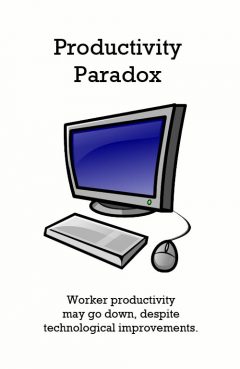Productivity Paradox (Solow Computer Paradox)

Release Date: //
Country of Release:
Length:
MPAA:
Medium: Paradox
Genre:
Release Message: Worker productivity may go down, despite technological improvements. Authored by Robert Solow.
Description: The productivity paradox was analyzed and popularized in a widely cited article by Erik Brynjolfsson, which noted the apparent contradiction between the remarkable advances in computer power and the relatively slow growth of productivity at the level of the whole economy, individual firms and many specific applications. The concept is sometimes referred to as the Solow computer paradox in reference to Robert Solow's 1987 quip, "You can see the computer age everywhere but in the productivity statistics." The paradox has been defined as the discrepancy between measures of investment in information technology and measures of output at the national level. It was widely believed that office automation was boosting labor productivity (or total factor productivity). However, the growth accounts didn't seem to confirm the idea. From the early 1970s to the early 1990s there was a massive slow-down in growth as the machines were becoming ubiquitous. (Other variables in country's economies were changing simultaneously; growth accounting separates out the improvement in production output using the same capital and labour resources as input by calculating growth in total factor productivity, AKA the "Solow residual".) The productivity paradox has attracted a lot of attention because technology seems no longer to be able to create the kind of productivity gains that occurred until the early 1970s. Some, such as economist Robert J. Gordon, are now arguing that technology in general is subject to diminishing returns in its ability to increase economic growth.